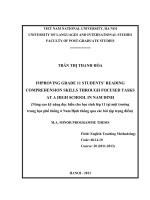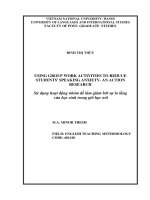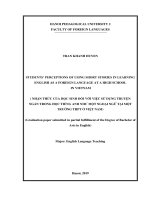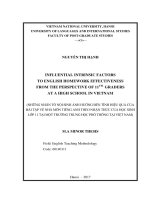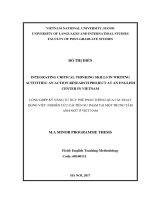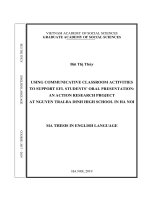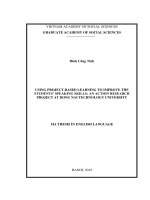Using online english newspapers to improve students’ reading skills an action research project at a high school in vietnam
Bạn đang xem bản rút gọn của tài liệu. Xem và tải ngay bản đầy đủ của tài liệu tại đây (1.05 MB, 79 trang )
VIETNAM NATIONAL UNIVERSITY, HANOI
UNIVERSITY OF LANGUAGES AND INTERNATIONAL STUDIES
FACULTY OF POST - GRADUATE STUDIES
*********************
NGUYỄN THỊ THỦY
USING ONLINE ENGLISH NEWSPAPERS TO IMPROVE
STUDENTS‟ READING SKILLS: AN ACTION RESEARCH
PROJECT AT A HIGH SCHOOL IN VIETNAM
(Sử dụng báo tiếng Anh mạng để nâng cao kỹ năng đọc cho học sinh:
Nghiên cứu cải tiến sư phạm tại mô ̣t trường trung ho ̣c phổ thông ở Việt Nam)
M.A. MINOR PROGRAMME THESIS
Field : English Teaching Methodology
Code: 60140111
HANOI - 2017
VIETNAM NATIONAL UNIVERSITY, HANOI
UNIVERSITY OF LANGUAGES AND INTERNATIONAL STUDIES
FACULTY OF POST - GRADUATE STUDIES
*********************
NGUYỄN THỊ THỦY
USING ONLINE ENGLISH NEWSPAPERS TO IMPROVE
STUDENTS‟ READING SKILLS: AN ACTION RESEARCH
PROJECT AT A HIGH SCHOOL IN VIETNAM
(Sử dụng báo tiếng Anh mạng để nâng cao kỹ năng đọc cho học sinh:
Nghiên cứu cải tiến sư phạm tại mô ̣t trường trung ho ̣c phổ thông ở Việt Nam)
M.A. MINOR PROGRAMME THESIS
Field : English Teaching Methodology
Code: 60140111
Supervisor: Dr. Dương Thị Nụ
HANOI - 2017
DECLARATION
I, Nguyễn Thị Thủy, hereby confirm that this minor thesis entitled ―Using
online English newspapers to improve students‘ reading skills. An action research
project at a high school in Vietnam‖ is my own study in fulfilment of the
requirement for the Degree of Master of Arts at the Faculty of Post Graduate
Studies, University of Languages and International Studies, Vietnam National
University, Hanoi. And it has not been published or submitted for any other
degrees.
Hanoi, 2017
Nguyễn Thi Thuy
̣
̉
i
ACKNOWLEDGEMENTS
On the completion of this graduation thesis, I would like to express my
deepest gratitude to many people.
First and foremost, I am heartily thankful to my supervisor, Dr. Dương Thị
Nụ, who gave me precious advice, critical comments and great encouragement
without which this thesis would not have been completed.
I am also deeply indebted to the lecturers at the Faculty of Post Graduate
Studies, University of Languages and International Studies, Vietnam National
University, Hanoi for their useful lectures and enthusiasm during my course.
In addition, my thanks go to the administrators, my colleagues and students
at Minh Khai high school for their willingness and enthusiasm to participate in this
project.
Last but not least, I would like to express my special gratitude to my family
who have always encouraged and supported me during my writing of the thesis.
ii
ABSTRACT
This action research was conducted to test the ideas that using online English
newspapers improves students‘ reading skills and cultivates their positive attitude
towards extensive reading (ER). The participants were 40 students at grade 12 at
Minh Khai high school, Đức Thọ district, Hà Tĩnh province. Reading materials
were selected from a local online English newspaper, vietnamnews at
Then, 16 reading tasks were designed with the adaption
from academic reading tasks suggested by Pauline Cullen et al (2014) in ―The
Official Cambridge Guide to IELTS‖. The whole project was carried out in 10
weeks. A pre-test and post-test were used before and after the application of the ER
program. Also, a questionnaire with three parts was administered to students before
and after the project. In addition, observation sheets were provided to two English
teachers to observe students‘ attitudes. The achieved results showed significant
improvement in students‘ reading skills, namely skimming and scanning and most
of the students expressed their positive attitudes towards the ER program. However,
to create a habit of reading extensively with an online English newspaper for
students, there seems to be a need of consideration of some factors like time or a
variety of local online English newspapers for students to choose.
iii
TABLE OF CONTENTS
DECLARATION ........................................................................................................ i
ACKNOWLEDGEMENTS ....................................................................................... ii
ABSTRACT .............................................................................................................. iii
TABLE OF CONTENTS .......................................................................................... iv
LIST OF ABBREVIATIONS ................................................................................... vi
LIST OF FIGURES.................................................................................................. vii
LIST OF CHARTS ................................................................................................. viii
LIST OF TABLES .................................................................................................... ix
PART A - INTRODUCTION ...................................................................................1
1. Rationale ...........................................................................................................1
2. Aims of the study ................................................................................................2
3. Research questions .................................................................................... 2
4. Scope of the study ...............................................................................................2
5. Method of the study ............................................................................................3
6. Design of the study .............................................................................................3
PART B - DEVELOPMENT....................................................................................5
CHAPTER 1: LITERATURE REVIEW ................................................................5
1.1. Definitions of key terms ..................................................................................5
1.1.1. Reading .....................................................................................................5
1.1.2. Reading skills............................................................................................6
1.1.3. Attitude......................................................................................................9
1.1.4. Online English newspapers ....................................................................10
1.2. Theoretical framework: Extensive reading (ER) ...........................................13
1.2.1. Definition of ER ......................................................................................13
1.2.2. Benefits of ER .........................................................................................14
1.2.3. Principles of running an ER program ....................................................16
1.3. Previous studies .............................................................................................17
1.3.1. Research on using English newspapers for reading ..............................17
1.3.2. Studies on students‘ attitudes .................................................................19
iv
1.3.3. Studies on skimming and scanning skills ...............................................20
1.4. Chapter summary ...........................................................................................21
CHAPTER 2: METHODOLOGY .........................................................................22
2.1. Context ...........................................................................................................22
2.2. Participants .....................................................................................................22
2.3. Research method ............................................................................................23
2.3.1. Reasons to use action research ..............................................................23
2.3.2. Action research procedures ....................................................................24
2.3.3. Data collection instruments ....................................................................32
2.3.4. Data collection method...........................................................................33
2.3.5. Data analysis procedures .......................................................................34
2.4. Chapter summary.......................................................................................34
CHAPTER 3: RESULTS AND DISCUSSION ....................................................35
3.1. Results of the tests .........................................................................................35
3.2 Results of questionnaires and teachers‘ observation sheets ...........................37
3.2.1. Results of questionnaires ........................................................................37
3.2.2. Results of teachers‘ observation ............................................................39
3.3. Discussion ......................................................................................................42
3.4. Chapter summary ...........................................................................................43
PART C – CONCLUSION .....................................................................................44
1. Conclusions .......................................................................................................44
2. Limitations of the study ....................................................................................45
3. Recommendations for further research .............................................................45
REFERENCES ........................................................................................................47
APPENDICES ........................................................................................................... I
APPENDIX 1 .......................................................................................................... I
APPENDIX 2 ....................................................................................................... VI
APPENDIX 3 ....................................................................................................... XI
APPENDIX 4 ...................................................................................................... XV
v
LIST OF ABBREVIATIONS
CALL
Computer-Assisted Language Learning
ER
Extensive Reading
EFL
English as a Foreign Language
ESL
English as a Second Language
H0
Null hypothesis
i
input
P
Probability value
sig.
Significance level
SPSS
Std. Deviation
Statistical Package for the Social Sciences
Standard Deviation
vi
LIST OF FIGURES
Figure 1: ........................................................................... 28
Figure 2: Eileen Ferrance‟s Action Research Cycle ............................................ 32
vii
LIST OF CHARTS
Chart 1: Percentage of students practising reading outside class ...................... 25
Chart 2: Students‟ opinions of the difficulty of reading skills ............................ 25
Chart 3: Students‟ opinions of factors causing difficulty in reading ................. 26
Chart 4: Students‟ opinions about the old ER program ..................................... 26
viii
LIST OF TABLES
Table 1: Types of reading tasks ............................................................................. 28
Table 2: The ER program with vietnamnews ...................................................... 30
Table 3: Results of the pre-test .............................................................................. 35
Table 4: Results of the post-test ............................................................................. 35
Table 5: Results of two tests ................................................................................... 36
Table 6: Paired sample correlation ....................................................................... 36
Table 7: Paired sample T-test ................................................................................ 37
Table 8: Results of the questionnaire (Question 12 to question 18) ................... 38
Table 9: Results of teachers‟ observation ............................................................. 40
ix
PART A - INTRODUCTION
1. Rationale
Due to the growth of globalization, English has become a lingua franca and
is considered as a means to bring about development and prosperity for a nation.
Vietnam is trying to integrate into the globalized world and placing great emphasis
on teaching and learning English. English, therefore, is a compulsory subject in the
National Curriculum. In Vietnam‘s National Foreign Languages 2020 Project, the
Ministry of Education and Training requires English language teachers to improve
their level and innovate teaching methods. Therefore, all innovative English
language teaching methods are highly appreciated. Along with grammar and
pronunciation, the English syllabus focuses on four skills- reading, speaking,
listening and writing. This research focuses on an innovative way to teach reading
skills with the application of online English language newspapers.
Every day everyone needs to read a variety of materials from a book to a
comic to obtain necessary information or to relax. Reading, therefore, plays an
important role in our daily life. Like other high schools in Vietnam, the teaching of
reading skills at Minh Khai high school is text-based. During each of three years at
school, students learn sixteen periods of reading with controlled topics. At Minh
Khai high school, students in grade 12 are given two more periods per week to
improve their English and get a good result in their graduation examination in
which English is a compulsory subject. Among four skills, reading seems to be the
most challenging. For students, they lack vocabulary and background knowledge to
complete reading tasks. For teachers, choosing suitable reading materials and
designing appropriate reading tasks for their students are big problems. During my
teaching process, I observed that students‘ reading habit is to translate reading
passages into Vietnamese in order to find the answers to the given questions. In
addition, results from 45 minute tests showed that most of my students were weak
at required reading skills in the syllabus such as skimming and scanning and they
are ―afraid‖ of learning reading. A solution to these problems needs to be found.
1
With up-to-date information in every field, English newspapers are really a
rich source for English language teachers to teach reading (Grundy, 1993 and
Sanderson, 1999). With comparison to printed English newspapers, online English
newspapers are more accessible. This makes me think that using online English
newspapers can improve my students‘ reading skills and help to cultivate their
positive attitude towards extensive reading (ER) which is the basis to create a
reading habit out-of-class. To achieve those aims, I did action research ―Using
online English newspapers to improve students‘ reading skills at Minh Khai high
school. I asked my students to do a pretest and a posttest to see the improvement in
their reading skills and answer a questionnaire to express their attitudes. Also,
observation from two teachers was analyzed to evaluate students‘ attitudes
objectively.
2. Aims of the study
There seems to be little research about using online English newspapers to
improve students‘ reading skills and make them interested in learning reading,
especially the research conducted with upper secondary students in Vietnam.
Therefore, the findings from the study are expected to be useful for both English
language teachers and upper-secondary students. They will have a supplementary
interesting way to teach and learn reading skills. As a result, teachers‘ teaching
materials will be enriched and students‘ reading skills will be improved.
3. Research questions
The study aims to answer the following questions:
1. To what extent can online English newspapers help to improve students‘
reading skills?
2. What are students‘ attitudes towards the ER program with online English
newspapers?
4. Scope of the study
The study was conducted in a class of 40 students in grade 12 at Minh Khai
high school, most of whom are at intermediate level of reading. The study focused
2
on the using of online English newspapers to improve their reading skills, which are
required in their curriculum. Eighteen articles were used to design sixteen reading
tasks which focused on skimming and scanning skills. All of the tasks are adapted
from academic reading tasks introduced by Pauline Cullen, Amanda French and
Vanessa Jakeman (2014) in ―The Official Cambridge Guide to IELTS for Academic
and General Training‖. Because the socio-cultural background knowledge plays an
important part in understanding newspaper articles, the local online English
newspaper, vietnamnews at vietnamnews.vn was exploited. This newspaper belongs
to Vietnam News Agency and it has native English sub-editors, which contributes
to the standard of languages used.
5. Method of the study
In this study, the author followed Eileen Ferrance‘s model of action research
(2000) including the following steps:
Step 1. Identification of the problem area
Step 2. Collection and organisation of the data
Step 3. Interpretation of data
Step 4. Action based on data
Step 5. Reflection
6. Design of the study
Within the scope mentioned above, the study is structured as follows:
Part A - Introduction
This part covers rationale, aims, scope and design of the study to introduce
and appeal the reader.
Part B- Development
This part consists of three following chapters.
Chapter 1: Literature Review -presents some theoretical background about
reading, reading skills, online English newspapers, ER, and an overview of previous
3
studies on using English newspapers as an ER program and those on students‘
attitude towards ER. This chapter aims to provide the readers with background
knowledge to have more understanding about the paper.
Chapter 2: Methodology - mentions the methods or approaches employed
by the author to collect the data for the study. The reasons why those methods were
chosen are also provided.
Chapter 3: Results and Discussion - analyses the data collected in the
research process and develops analytic and critical thinking on the achieved results
and analysis with reference to theoretical arguments presented in the literature
review.
Part C – Conclusion- presents a summary of the findings, conclusions,
limitations, and recommendations for further research. Following this part are
References and Appendices.
4
PART B - DEVELOPMENT
CHAPTER 1: LITERATURE REVIEW
This section presents definitions of key terms and points out the direction of
the study. In this research, using online English newspapers is relevant to ER and
students‘ attitudes. Also, previous studies about using English newspapers to
develop students‘ reading skills and students‘ attitudes towards reading are
mentioned.
1.1. Definitions of key terms
1.1.1. Reading
Reading is an important skill in the language learning process and many
researchers have defined it in different ways.
Harmer (1989: 190) defines ―reading is an exercise dominated by the eyes
and the brain. The eyes receive message and the brain then has to work out the
significance of the message‖. Reading thereby is considered as a ―receptive skill‖
whose aim is to extract a message from the written text (Harmer, 1930; Ur, 1996;
Richard and Platt, 1992). However, the concept ―receptive skill‖ appears to reflect
the passive role of readers who pick up information from the page.
Other researchers tend to have a deeper look into reading. They realize that
reading is a complex process with the involvement of various elements. Smith
(2004: 73) points out that:
Access to visual information is a necessary part of reading, but not
sufficient… Knowledge of the relevant language is essential for
reading, but you can‘t expect to find it on the printed page. Rather it
is information that you must have already, behind the eyeball. It can
be distinguished …by being called non-visual information or prior
knowledge.
Anderson (1999:1) shares the same view and he considers ‗non-visual
information‘ as the reader‘s background knowledge and experience. In other words,
reading is not a passive process. Reading is an ―interactive‖ process between a
5
reader and a text, which leads to automaticity. In this process, the reader interacts
dynamically with the text as he or she tries to elicit the meaning and various kinds
of knowledge being used: linguistic or systemic knowledge (through bottom-up
processing) as well as schematic knowledge (through top-down processing)
(Bernhardt, 1986; Carrell, Devine & Eskey, 1988; Rumelhart, 1977; Nuttall, 2000).
These factors have been summarized and synthesized by MacLachlan and Reid
(1994:3-4) as the interpretive framing which consists of four following types of
framing:
- Extratextual framing - using information outside the text, your background
knowledge and experience, to understand texts.
- Intratextual framing - making use of cues from the text, such as headings and subheadings and referential words such as "this" and "that" to understand texts.
- Intertextual framing - making connections with other texts you are reading to help
to understand your text.
- Circumtextual framing - using information from the cover of the book, title,
abstract, references etc. to understand the text.
The author of this study follows the view that reading is an interactive
process between the reader and the text which is visualized by decoding process of
the written texts and supported with a variety of knowledge mentioned by
MacLachlan and Reid in which socio-cultural background knowledge plays an
important role.
1.1.2. Reading skills
Woolley (2011: 33-34) considers reading skills as the means to ―gain
meaning from text by constructing a text-based model while at the same time they
(skilled readers) draw upon and use their own background knowledge to construct
a situation model of the understandings related to the text passage.‖
Different researchers have proposed different types of reading skills. Davis
(1944) (as cited by Afflerbach, Person and Paris , 2008: 367) suggests nine skills of
6
reading comprehension: word meanings, word meanings in context, follow passage
organization, main thought, answer specific text-based questions, text-based
questions with paraphrase, draw inferences about the content, literary devices, and
author purpose. Similarly, Harmer (1986) mentions a number of reading skills such
as predicting, guessing word meaning, reading for specific information, reading for
general comprehension, scanning, skimming, inferring from texts, interpreting
texts, surveying text organisation, and critically evaluating texts. Grellet (1981:3)
shares the same view and he gives a list of shorter terms such as predicting,
skimming, scanning, and inference.
This study mainly focuses on the reading skills in Tiế ng Anh 12 whose chief
editor is Hoàng Văn Vân (2007), namely skimming and scanning which are
considered as ―the two most valuable reading strategies for learners as well as
native speakers‖ (Brown, 1994:283)
1.1.2.1. Skimming
To skim an article, readers can use different strategies such as reading the
headline, the first paragraph, the last paragraph or focusing on nouns, etc. All of
these help readers to seek the main idea or get the ―gist‖ (Maxwell, 1969) or ―the
general sense‖ (Allen, 1997) of the reading material. This useful activity is
essential for choosing a newspaper item. Its aim is to train students to skim through
the text to get some kind of rough idea of what the newspaper is about or of the
way it is written to see the important information. Skimming does not require high
level of comprehension so it is quite appropriate for students at intermediate level.
Therefore, skimming is considered as part of top-down reading approach or
―concept-driven‖ process which is ―a psycholinguistic guessing game‖ (Goodman,
1971:135). This process is described as ―skapa‖ by Maxwell (1973), which
includes three steps: select clue words, label or classify clue words, and construct
or synthesize the main idea from the collected labels. These steps will be applied in
the ER reading program with the online English newspaper.
7
1.1.2.2. Scanning
When readers try to locate specifically required information such as places,
names, numbers, they do not need to read the whole text carefully. Instead, they try
to find in which paragraph the information they are looking for is likely to be, then
read this paragraph with more attention. This task is used to train the students to run
their eyes over a text quickly to find specific information. In comparison to
skimming, scanning belongs to the bottom-up reading process which is ―datadriven‖ reading process and it requires in-depth reading (Goodman, 1971:135).
Also, scanning plays an important role in increasing students‘ reading
comprehension because ―rapid scanning speeds are associated with higher
accuracy‖ (Maxwell, 1972).
Therefore, I do not follow Nunan‘s view that considers both skimming and
scanning ―involve fairly rapid superficial reading and both are aimed at searching,
rather than deep processing of the text or reflection upon the content of the text‖
(Nunan, 1999:251). On the contrary, I follow Nuttall‘s view (1996) that these skills
do not remove the need for reading carefully and they help readers select parts of
the text, that are worth spending time on. With these two skills, students can get
enough ideas about articles. Beale (2013) adds that ―people who know how to skim
and scan are flexible readers. They read according to their purpose and get the
information they need quickly without wasting time…Their skill lies in knowing
what specific information to read and which method to use‖.
1.1.2.3. How to use skimming and scanning
With regard to the strategies of reading, Richards (1989:145) proposes some
as follows:
-Strategy A: Read the text, read the comprehension questions, then go back and
skim for answers. This is the most detailed way of reading the text.
- Strategy B: Read the questions, read the text carefully to find the answers, then go
back and check the answer against the questions.
- Strategy C: Skim the text, read the questions then scan for the answers.
8
- Strategy D: Read the questions and skim for the answers. This is the fastest
strategy.
However, Nuttall (1996) points out that whether skimming or scanning is
used, there is need to read carefully to determine the location of different parts of
the text. Also, Richards (1989:20) emphasizes that different types of reading
materials require different strategies.
With respect to the purpose of reading newspapers (to update news), readers
often read titles (skim) to know what is going to be mentioned in the article and
then read for key words or numbers (scan) to know more about the news. When the
author of this research designs the reading tasks from articles, this principle is not
emphasized because Push (1978) points out that scanning can be introduced first
because it is less complicated in comparison with skimming which requires greater
fluency and more practice. And to improve these two skills, Maxwell (1972)
suggested that adequate skimming and scanning training should be incorporated in
a rapid- reading course. The ER program with an online English newspaper,
thereby, is expected to achieve great improvement in students‘ skimming and
scanning skills.
1.1.3. Attitude
According to Kerlinger (1984), attitude is a ―multidimensional‖ factor
which predisposes a person‘s selection of behaviours toward something. Similarly,
Ajzen (1987) and Mager (1986) state that attitudes determine a person‘s emotion
and response to a person, a thing or an activity. Also, they divide attitude into two
types: positive (favorable) and negative (unfavorable). In language education,
attitudes play an important role. Fakeye (2010) stated that learner‘s attitude is one
of the most important factors having effect on learning a language. Also, Dornyei
(1996) confirms that students with more favorable attitudes toward the second
language and its speakers are likely to be more successful in the language learning
than otherwise.
With regard to elements of attitude, Mathews (1994) lists three ones:
9
affective, cognitive and behavioral. In other words, it includes emotion, thought
and response. This view is explained more by Visser et al (2004) who confirmed
that once a person is sure and confident with his thought and belief toward a
matter, he will have a positive behaviour to it.
When learning to read, students show their reading attitude which has been
defined by many researchers with different focuses. According to Alexander &
Filler (1976:1), reading attitude is ―a system of feelings related to reading which
causes the learner to approach or avoid a reading situation‖. They emphasize the
affective component of attitude and its role in determining learners‘ behaviour.
Meanwhile, Smith (1990: 215) includes all of the three elements of attitude in his
definition of reading attitude- ―a state of mind, accompanied by feelings and
emotions, which makes reading more or less probable‖. As a result, when an ER
program is applied, students certainly express their reading attitude which reflects
the appropriateness and efficiency of the program.
The author of this research follows the view that attitude is a factor affecting
students‘ feeling, thought and behavior. With the aim to test the appropriateness
and efficiency of the ER program through students‘ attitudes, a survey focusing on
these three elements of students‘ reading attitude was conducted. The results of the
questionnaire were also supplemented by two teachers‘ observation.
1.1.4. Online English newspapers
1.1.4.1. Characteristics of online English newspapers
Online English newspapers as well as printed ones are authentic materials
because they are ―…real-life texts, not written for pedagogic purposes‖ (Wallace
1992: 145). According to Reah (2002: 13), newspapers are ―ephemeral texts, that is,
they are intended only for the day they are delivering the news‖. Compared to
printed English versions and other materials, online English newspapers are more
updated, more visually stimulating and more interactive. Grundy (1993), Sanderson
(1999) and Reah (2002) have summarized some prominent features of online
10
English newspapers as follows:
Firstly, they include a system of interrelated lexical, phraseological and
grammatical means serving the purpose of informing, instructing, and entertaining
the reader. Because of these diverse purposes, newspaper language involves a wide
range of styles.
Secondly, online newspapers have both general educational and cultural
values. They keep us informed about what is happening in the world, thereby
extending our knowledge and deepening our understanding. In addition to that
general educational value, any newspaper of a given target community reflects its
culture through the language it contains because culture permeates language
through references to the people, places, institutions, customs and traditions of that
community.
Last but not least, like printed ones, online English newspapers use language
naturally and cover many things which are not included in textbooks but popular in
real life. Reading newspapers, students will know how to use language naturally
and widen their banks of vocabulary, especially economic terms or political terms,
newspaper clichés, and neologisms.
Seeing that students may encounter a problem of vocabulary and cultural
knowledge, Grundy proposes using local English newspapers in non-native English
speaking country. In Vietnam, students can have access to some local online
English newspapers such as vietnamplus (en.vietnamplus.vn) or vietnamnews
(vietnamnews.vn) which cover information in all fields - politics & laws, society,
economy, life & style, sports, and environment. When running the ER program, I
chose Vietnamnews.vn, whose sub-editors are English, to ensure that students can
make most of their background knowledge and experience in reading for gist as
well as for specific information.
1.1.4.2. Benefits of using online English newspapers
In a foreign language classroom, online English newspapers as well as
11
printed ones are a rich source of reading materials with many positive effects.
Grundy (1993) and Sanderson (1999) confirm the importance of using English
newspapers in the classroom because of the following benefits:
Firstly, students are informed about the latest information in the world,
thereby enriching their knowledge and deepening their understanding. Their sociocultural knowledge can be widened.
Secondly, in terms of linguistics, students can know current changes in the
language and they become familiar with a wide variety of text types and language
styles.
Thirdly, online newspapers are authentic materials. With real-life events,
newspapers make students curious to read. Reading newspapers as a pastime will
motivate students to read outside the classroom, thereby extending their contact
with English.
Moreover, online English newspapers are a limitless supply of teaching and
learning materials with a wide range of levels from Elementary to Advanced. They
have items with different length and styles, so readers can progress from short items
to longer ones. They are rich in information, so students have many subjects to
choose and ―reading about interesting new things in one‘s specialist subject
undoubtedly helps motivation‖ (Sanderson, 1999).
Finally, working with online English newspapers not only gives students
opportunities for improving their language skills, but also for increasing their
critical-thinking and collaborative abilities. Incorporating news media into the ESL
classroom gives them the tools and the confidence to follow the news in class, and
also to continue to follow the news well into the future.
To achieve these benefits, teachers should prepare carefully the reading
materials and guide students clearly. The size of vocabulary and cultural knowledge
has to be taken into consideration before applying the ER program. Procedures of
running it must be designed in compatibility with the theoretical framework of ER
which is mentioned in the following part.
12
1.2. Theoretical framework: Extensive reading (ER)
1.2.1. Definition of ER
Different researchers have different definitions of ER. Hafiz and Tudor
(1989: 4) consider ER as ―the reading of large amounts of material in the second
language over time for personal pleasure or interest, and without the addition of
productive tasks or follow up language work‖. Also, Davies (1995:329) provides a
detailed description of ER in the context of ELT classroom. According to him, an
ER program in an ELT course is compared to an additional class-library idea where
students are provided not only with a large number of books but also with enough
time, motivation and encouragement to read them. He emphasizes that there is no
pressure of formal assessment or marking in an extensive program, the pupils do not
have to worry about competing with others. Similarly, Hedge (2000) states that ER
―enables student to achieve independency by reading the material they want in
consideration to content, level of difficulty, and length and they are promoted to
learn how to increase their reading speed through which, by sure, they learn how to
locate certain information to help them reach the main and basic ideas‖. This view
is shared by Walter (2003) who defines ER as reading of texts chosen by the
learners themselves to get information with enjoyment and the texts do not seem
problematic. Nuttall (2004: 35) also emphasizes that because ER offers a large
amount of reading materials, it occurs mainly out-of- class.
All the researchers point out that ER involves reading a large amount of
reading materials which are chosen by students themselves according to their
interest , with no time pressure and the purpose that is to have general
understanding, enjoyment and fluency. Therefore, ER has two prominently
contrastive features (high volume and low difficulty) in comparison with intensive
reading (low volume and high difficulty) which occurs mainly in class. Moreover,
Hedge (2000: 218) states that ―since ER helps in developing reading ability, it
should be built into an EFL/ESL program provided that the selected texts are
"authentic - i.e." not written for language learners and published in original
13
language".
Undoubtedly, with the features of online English newspapers mentioned
above, the ER program in this project is quite appropriate and is expected to achieve
good results thanks to the benefits of ER which will be presented in the next part.
1.2.2. Benefits of ER
Ellis (2004: 217) states that ―successful instructed language learning requires
extensive second language input‖ and the effectiveness of ER to develop students‘
language competence has been demonstrated by many studies. The researchers of
those studies have proposed different lists of benefits of ER which can be analyzed
in two levels: the knowledge and skills learners can get from ER, and better
qualities established in the self of the learner (Day, 1998; Bell, 2001; Nation, 2001;
Porcaro, 2009). In terms of the knowledge and skills, students can get
comprehensible input, improve their banks of vocabulary and grammar, enhance
reading fluency, and develop general language competence. In regard to the
qualities of a learner, ER increases students‘ motivation and confidence in reading,
develop their autonomy by instilling in them a love of reading.
Firstly, ER provides comprehensible input (i) for learners, which is ―constant
massive exposure‖ to language. According to Krashen‘s input hypothesis,
comprehensibility is one of the most important factors in deciding students‘ interest.
Krashen (1985) uses the formula i+1 while Day Richard (1998) uses i-1 to describe
their ideas. The author of this study follows Krashen‘s criteria of input which is also
appropriate with the features of newspapers. Students can read a large amount of
their favorite materials, as a result, they are sure to have a great deal of exposure to
the language. Through this way, they will be able to encounter new sources of
language, consolidate what they have learnt and develop their prediction skills. This
benefit will facilitate the learning conditions for students and enhance their learning
results, which helps both teachers and students overcome the problem of time
constraint in class.
Secondly, vocabulary and grammar are developed by reading extensively.
14
